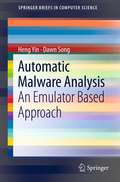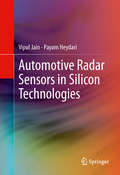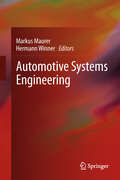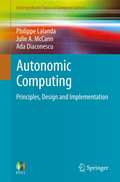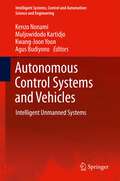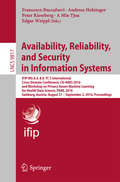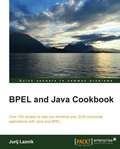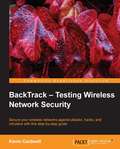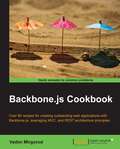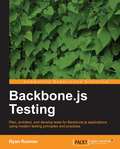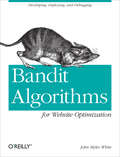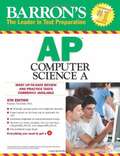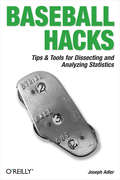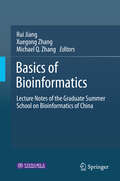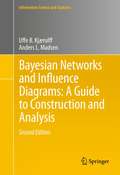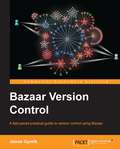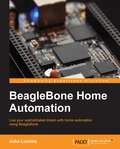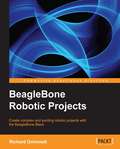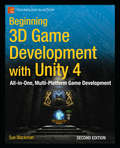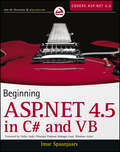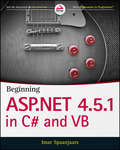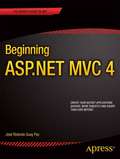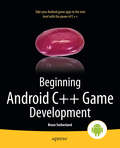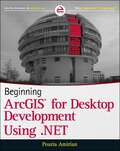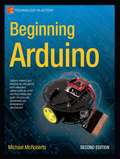- Table View
- List View
Automatic Malware Analysis: An Emulator Based Approach (SpringerBriefs in Computer Science)
by Heng Yin Dawn SongMalicious software (i.e., malware) has become a severe threat to interconnected computer systems for decades and has caused billions of dollars damages each year. A large volume of new malware samples are discovered daily. Even worse, malware is rapidly evolving becoming more sophisticated and evasive to strike against current malware analysis and defense systems. Automatic Malware Analysis presents a virtualized malware analysis framework that addresses common challenges in malware analysis. In regards to this new analysis framework, a series of analysis techniques for automatic malware analysis is developed. These techniques capture intrinsic characteristics of malware, and are well suited for dealing with new malware samples and attack mechanisms.
Automotive Radar Sensors in Silicon Technologies: Circuits And Systems
by Payam Heydari Vipul JainOne of the leading causes of automobile accidents is the slow reaction of the driver while responding to a hazardous situation. State-of-the-art wireless electronics can automate several driving functions, leading to significant reduction in human error and improvement in vehicle safety. With continuous transistor scaling, silicon fabrication technology now has the potential to substantially reduce the cost of automotive radar sensors. This book bridges an existing gap between information available on dependable system/architecture design and circuit design. It provides the background of the field and detailed description of recent research and development of silicon-based radar sensors. System-level requirements and circuit topologies for radar transceivers are described in detail. Holistic approaches towards designing radar sensors are validated with several examples of highly-integrated radar ICs in silicon technologies. Circuit techniques to design millimeter-wave circuits in silicon technologies are discussed in depth.
Automotive Systems Engineering
by Hermann Winner Markus MaurerThis book reflects the shift in design paradigm in automobile industry. It presents future innovations, often referred as "automotive systems engineering". These cause fundamental innovations in the field of driver assistance systems and electro-mobility as well as fundamental changes in the architecture of the vehicles. New driving functionalities can only be realized if the software programs of multiple electronic control units work together correctly. This volume presents the new and innovative methods which are mandatory to master the complexity of the vehicle of the future.
Autonomic Computing: Principles, Design and Implementation (Undergraduate Topics in Computer Science)
by Julie A. Mccann Ada Diaconescu Philippe LalandaThis textbook provides a practical perspective on autonomic computing. Through the combined use of examples and hands-on projects, the book enables the reader to rapidly gain an understanding of the theories, models, design principles and challenges of this subject while building upon their current knowledge. Features: provides a structured and comprehensive introduction to autonomic computing with a software engineering perspective; supported by a downloadable learning environment and source code that allows students to develop, execute, and test autonomic applications at an associated website; presents the latest information on techniques implementing self-monitoring, self-knowledge, decision-making and self-adaptation; discusses the challenges to evaluating an autonomic system, aiding the reader in designing tests and metrics that can be used to compare systems; reviews the most relevant sources of inspiration for autonomic computing, with pointers towards more extensive specialty literature.
Autonomous Control Systems and Vehicles: Intelligent Unmanned Systems (Intelligent Systems, Control and Automation: Science and Engineering #65)
by Kenzo Nonami Agus Budiyono Kwang-Joon Yoon Muljowidodo KartidjoThe International Conference on Intelligent Unmanned Systems 2011 was organized by the International Society of Intelligent Unmanned Systems and locally by the Center for Bio-Micro Robotics Research at Chiba University, Japan. The event was the 7th conference continuing from previous conferences held in Seoul, Korea (2005, 2006), Bali, Indonesia (2007), Nanjing, China (2008), Jeju, Korea (2009), and Bali, Indonesia (2010). ICIUS 2011 focused on both theory and application, primarily covering the topics of robotics, autonomous vehicles, intelligent unmanned technologies, and biomimetics. We invited seven keynote speakers who dealt with related state-of-the-art technologies including unmanned aerial vehicles (UAVs) and micro air vehicles (MAVs), flapping wings (FWs), unmanned ground vehicles (UGVs), underwater vehicles (UVs), bio-inspired robotics, advanced control, and intelligent systems, among others. This book is a collection of excellent papers that were updated after presentation at ICIUS2011. All papers that form the chapters of this book were reviewed and revised from the perspective of advanced relevant technologies in the field. The aim of this book is to stimulate interactions among researchers active in the areas pertinent to intelligent unmanned systems.
Availability, Reliability, and Security in Information Systems: IFIP WG 8.4, 8.9, TC 5 International Cross-Domain Conference, CD-ARES 2016, and Workshop on Privacy Aware Machine Learning for Health Data Science, PAML 2016, Salzburg, Austria, August 31 - September 2, 2016, Proceedings (Lecture Notes in Computer Science #9817)
by Andreas Holzinger Edgar Weippl A Min Tjoa Francesco Buccafurri Peter KiesebergThis book constitutes the refereed proceedings of the IFIP WG 8. 4, 8. 9, TC 5 International Cross-Domain Conference on Availability, Reliability and Security, CD-ARES 2013, held in Regensburg, Germany, in September 2013. The 21 revised papers presented were carefully reviewed and selected for inclusion in the volume. The papers concentrate on the many aspects of information systems bridging the gap between research results in computer science and the many application fields. They are organized in the following topical sections: economic, ethical, legal, multilingual, organizational and social aspects; context-oriented information integration; data/information management as a service; context-oriented information integration and location-aware computing; security and privacy; risk management and business continuity; and security and privacy and location based applications. Also included are 15 papers from a special session on Human-Computer Interaction and Knowledge Discovery (HCI-KDD 2013).
BPEL and Java Cookbook
by Jurij LaznikThe book is written in a Cookbook format with practical recipes aimed at helping you extend BPEL capabilities with Java.This book is aimed at Java developers who use BPEL programming to develop web services in SOA development. It is assumed that the readers are experienced with Java programming and SOA, but knowledge of BPEL is not necessarily required.
BackTrack – Testing Wireless Network Security
by Kevin CardwellWritten in an easy-to-follow step-by-step format, you will be able to get started in next to no time with minimal effort and zero fuss.BackTrack: Testing Wireless Network Security is for anyone who has an interest in security and who wants to know more about wireless networks.All you need is some experience with networks and computers and you will be ready to go.
Backbone.js Cookbook
by Vadim MirgorodWritten in a friendly, example driven Beginner's Guide format, there are plenty of step-by-step instructions to get you started fast!Pentaho 4.0 By Example: Beginner's Guide is the ideal companion for a wide-variety of developers. Whether you are new to the world of Business Intelligence reporting, or an experienced BI analyst, this book will guide you through the creation of your first reports in Pentaho. We assume some knowledge of the SQL language and database systems.
Backbone.js Testing
by Ryan RoemerThis book is packed with the step by step tutorial and instructions in recipe format helping you setup test infrastructure and gradually advance your skills to plan, develop, and test your backbone applications.If you are a JavaScript developer looking for recipes to create and implement test support for your backbone application, then this book is ideal for you.
Bandit Algorithms for Website Optimization: Developing, Deploying, and Debugging
by John Myles WhiteWhen looking for ways to improve your website, how do you decide which changes to make? And which changes to keep? This concise book shows you how to use Multiarmed Bandit algorithms to measure the real-world value of any modifications you make to your site. Author John Myles White shows you how this powerful class of algorithms can help you boost website traffic, convert visitors to customers, and increase many other measures of success.This is the first developer-focused book on bandit algorithms, which were previously described only in research papers. You’ll quickly learn the benefits of several simple algorithms—including the epsilon-Greedy, Softmax, and Upper Confidence Bound (UCB) algorithms—by working through code examples written in Python, which you can easily adapt for deployment on your own website.Learn the basics of A/B testing—and recognize when it’s better to use bandit algorithmsDevelop a unit testing framework for debugging bandit algorithmsGet additional code examples written in Julia, Ruby, and JavaScript with supplemental online materials
Barron's AP Computer Science A (6th Edition)
by Roselyn TeukolskyThe updated test prep manual presents computer science test takers with-- Three full-length AP practice tests for the Level A course, including a diagnostic test Charts detailing the topics for each test question All test questions answered and explained Test takers will also find an extensive subject review including sections on static variables, the List interface, Integer. MAX_VALUE, and Integer. MIN_VALUE. The practice exams contain several new questions on two-dimensional arrays and also reflect the new free-response style used on the 2012 AP exam.
Baseball Hacks: Tips & Tools for Analyzing and Winning with Statistics
by Joseph AdlerBaseball Hacks isn't your typical baseball book--it's a book about how to watch, research, and understand baseball. It's an instruction manual for the free baseball databases. It's a cookbook for baseball research. Every part of this book is designed to teach baseball fans how to do something. In short, it's a how-to book--one that will increase your enjoyment and knowledge of the game. So much of the way baseball is played today hinges upon interpreting statistical data. Players are acquired based on their performance in statistical categories that ownership deems most important. Managers make in-game decisions based not on instincts, but on probability - how a particular batter might fare against left-handedpitching, for instance. The goal of this unique book is to show fans all the baseball-related stuff that they can do for free (or close to free). Just as open source projects have made great software freely available, collaborative projects such as Retrosheet and Baseball DataBank have made great data freely available. You can use these data sources to research your favorite players, win your fantasy league, or appreciate the game of baseball even more than you do now. Baseball Hacks shows how easy it is to get data, process it, and use it to truly understand baseball. The book lists a number of sources for current and historical baseball data, and explains how to load it into a database for analysis. It then introduces several powerful statistical tools for understanding data and forecasting results. For the uninitiated baseball fan, author Joseph Adler walks readers through the core statistical categories for hitters (batting average, on-base percentage, etc.), pitchers (earned run average, strikeout-to-walk ratio, etc.), and fielders (putouts, errors, etc.). He then extrapolates upon these numbers to examine more advanced data groups like career averages, team stats, season-by-season comparisons, and more. Whether you're a mathematician, scientist, or season-ticket holder to your favorite team, Baseball Hacks is sure to have something for you. Advance praise for Baseball Hacks: "Baseball Hacks is the best book ever written for understanding and practicing baseball analytics. A must-read for baseball professionals and enthusiasts alike."-- Ari Kaplan, database consultant to the Montreal Expos, San Diego Padres, and Baltimore Orioles"The game was born in the 19th century, but the passion for its analysis continues to grow into the 21st. In Baseball Hacks, Joe Adler not only demonstrates thatthe latest data-mining technologies have useful application to the study of baseball statistics, he also teaches the reader how to do the analysis himself, arming the dedicated baseball fan with tools to take his understanding of the game to a higher level."-- Mark E. Johnson, Ph.D., Founder, SportMetrika, Inc. and Baseball Analyst for the 2004 St. Louis Cardinals
Basics of Bioinformatics: Lecture Notes of the Graduate Summer School on Bioinformatics of China
by Rui Jiang Xuegong Zhang Michael Q. ZhangThis book outlines 11 courses and 15 research topics in bioinformatics, based on curriculums and talks in a graduate summer school on bioinformatics that was held in Tsinghua University. The courses include: Basics for Bioinformatics, Basic Statistics for Bioinformatics, Topics in Computational Genomics, Statistical Methods in Bioinformatics, Algorithms in Computational Biology, Multivariate Statistical Methods in Bioinformatics Research, Association Analysis for Human Diseases: Methods and Examples, Data Mining and Knowledge Discovery Methods with Case Examples, Applied Bioinformatics Tools, Foundations for the Study of Structure and Function of Proteins, Computational Systems Biology Approaches for Deciphering Traditional Chinese Medicine, and Advanced Topics in Bioinformatics and Computational Biology. This book can serve as not only a primer for beginners in bioinformatics, but also a highly summarized yet systematic reference book for researchers in this field. Rui Jiang and Xuegong Zhang are both professors at the Department of Automation, Tsinghua University, China. Professor Michael Q. Zhang works at the Cold Spring Harbor Laboratory, Cold Spring Harbor, NY, USA.
Bayesian Networks and Influence Diagrams: A Guide To Construction And Analysis (Information Science and Statistics #22)
by Uffe B. Kjærulff Anders L. MadsenBayesian Networks and Influence Diagrams: A Guide to Construction and Analysis, Second Edition, provides a comprehensive guide for practitioners who wish to understand, construct, and analyze intelligent systems for decision support based on probabilistic networks. This new edition contains six new sections, in addition to fully-updated examples, tables, figures, and a revised appendix. Intended primarily for practitioners, this book does not require sophisticated mathematical skills or deep understanding of the underlying theory and methods nor does it discuss alternative technologies for reasoning under uncertainty. The theory and methods presented are illustrated through more than 140 examples, and exercises are included for the reader to check his or her level of understanding. The techniques and methods presented for knowledge elicitation, model construction and verification, modeling techniques and tricks, learning models from data, and analyses of models have all been developed and refined on the basis of numerous courses that the authors have held for practitioners worldwide.
Bazaar Version Control
by Janos GyerikThis book is a step-by-step tutorial for beginner to intermediate developers who want to get started with Bazaar quickly.This book is designed for anyone who may be new to version control systems. If you are a programmer, system administrator, designer, writer, or translator, you can benefit greatly from using Bazaar in your projects. Those who are familiar with version control systems will find this book a fast and easy way to understand Bazaar.
BeagleBone Home Automation
by Juha LummeAn easy-to-follow guide full of hands-on examples to help transform your house into a standalone home automation solution.If you are looking for ways to create a highly capable home automation system that is easily extendable and highly configurable, then this book is for you. Basic knowledge of electronics and programming in Python and/or Java languages will be helpful, but not mandatory.
BeagleBone Robotic Projects
by Richard GrimmettDevelop practical example projects with detailed explanations; combine the projects in a vast number of ways to create different robot designs, or work through them in sequence to discover the full capability of the BeagleBone Black.This book is for anyone who is curious about using new, low-cost hardware to create robotic projects that have previously been the domain of research labs, major universities or Defence departments. Some programming experience would be useful, but if you know how to use a personal computer, you can use this book to construct far more complex systems than you would have thought possible.
Beginning 3D Game Development with Unity 4: All-in-one, multi-platform game development
by Sue BlackmanBeginning 3D Game Development with Unity 4 is perfect for those who would like to come to grips with programming Unity. You may be an artist who has learned 3D tools such as 3ds Max, Maya, or Cinema 4D, or you may come from 2D tools such as Photoshop and Illustrator. On the other hand, you may just want to familiarize yourself with programming games and the latest ideas in game production. This book introduces key game production concepts in an artist-friendly way, and rapidly teaches the basic scripting skills you'll need with Unity. It goes on to show how you, as an independent game artist, can create interactive games, ideal in scope for today's casual and mobile markets, while also giving you a firm foundation in game logic and design. The first part of the book explains the logic involved in game interaction, and soon has you creating game assets through simple examples that you can build upon and gradually expand. In the second part, you'll build the foundations of a point-and-click style first-person adventure game--including reusable state management scripts, dialogue trees for character interaction, load/save functionality, a robust inventory system, and a bonus feature: a dynamically configured maze and mini-map. With the help of the provided 2D and 3D content, you'll learn to evaluate and deal with challenges in bite-sized pieces as the project progresses, gaining valuable problem-solving skills in interactive design. By the end of the book, you will be able to actively use the Unity 3D game engine, having learned the necessary workflows to utilize your own assets. You will also have an assortment of reusable scripts and art assets with which to build future games. What you'll learn How to build interactive games that work on a variety of platforms Take the tour around Unity user interface fundamentals, scripting and more Create a test environment and gain control over functionality, cursor control, action objects, state management, object metadata, message text and more What is inventory logic and how to manage it How to handle 3D object visibility, effects and other special cases How to handle variety of menus and levels in your games development How to handle characters, scrollers, and more How to create or integrate a story/walkthrough How to use the new Mecanim animation Who this book is for Students or artists familiar with tools such as 3ds Max or Maya who want to create games for mobile platforms, computers, or consoles, but with little or no experience in scripting or the logic behind games development. Table of Contents 01. Introduction to Game Development 02. Unity UI basics 03. Introduction to Scripting 04. Terrain Generation and Environment 05. Exploring Navigation 06. Cursor Control and Interaction 07. Importing Assets 08. Action Objects 09. Managing State 10. Exploring Transitions 11. Physics and Special Effects 12. Message Text and HUD 13. Inventory Logic 14. Managing Inventory 15. Dialogue Trees 16. Mecanim 17. Game Environment 18. Setting up the Game 19. Menus and Levels
Beginning ASP.NET 4.5: In C# And Vb
by Imar SpaanjaarsThe ultimate programming guide to ASP.NET 4.5, by popular author and Microsoft MVP Imar Spaanjaars Updated for ASP.NET 4.5, this introductory book is filled with helpful examples and contains a user-friendly, step-by-step format. Written by popular author and Microsoft ASP.NET MVP Imar Spaanjaars, this book walks you through ASP.NET, Microsoft's technology for building dynamically generated web pages. This edition retains the highly accessible approach to building the Planet Wrox website example, an online community site featuring product reviews, picture sharing, bonus content for registered users, and more. Contains the comprehensive guide to the latest technology additions to ASP.NET 4.5 Shows how to build basic ASP.NET web pages and configure their server Includes information on how to add features with pre-built server controls Reveals how to design pages and make them consistent Contains the information needed for getting user input and displaying data Beginning ASP.NET 4.5 in C# and VB uses Spaanjaars's distinct writing style to put you at ease with learning ASP.NET 4.5.
Beginning ASP.NET 4.5: in C# and VB
by Imar SpaanjaarsThe ultimate programming guide to ASP. NET 4. 5, by popular author and Microsoft MVP Imar Spaanjaars Updated for ASP. NET 4. 5, this introductory book is filled with helpful examples and contains a user-friendly, step-by-step format. Written by popular author and Microsoft ASP. NET MVP Imar Spaanjaars, this book walks you through ASP. NET, Microsoft's technology for building dynamically generated web pages. This edition retains the highly accessible approach to building the Planet Wrox website example, an online community site featuring product reviews, picture sharing, bonus content for registered users, and more. Contains the comprehensive guide to the latest technology additions to ASP. NET 4. 5 Shows how to build basic ASP. NET web pages and configure their server Includes information on how to add features with pre-built server controls Reveals how to design pages and make them consistent Contains the information needed for getting user input and displaying data Beginning ASP. NET 4. 5 in C# and VB uses Spaanjaars's distinct writing style to put you at ease with learning ASP. NET 4. 5.
Beginning ASP.NET MVC 4
by Jose Rolando Guay PazBy now you'll have heard of ASP.NET MVC. This excitingnew approach to developing ASP.NET web applications has taken thedevelopment world by storm over the last few years. Now a mature technology suitable for mainstream use, its adoption has exploded in recent times. Until recently, ASP.NET MVC was regarded as an advanced technology only suitable for experienced developers with a strong knowledge of classic ASP.NET and C# coding behind them. This book overturns that prejudice and shows that the beautiful simplicity of ASP.NET MVC is just as suitable for novice developers venturing into real-world application design for the first time. With the aid of a fully worked demo application this bookexplains and demonstrates for you the three pillars of MVC in action. You'll see howthe Model, View and Controller patterns work together in a compliementarymanner to provide MVC's powerful results. There's never been a better time to learn how to use ASP.NETMVC 4. The technology will speed your development times, reduce theverbosity of your code and simplify your application designs all at once. Takethe first step towards ASP.NET MVC mastery with Beginning ASP.NET MVC 4.
Beginning Android C++ Game Development
by Bruce SutherlandBeginning Android C++ Game Development introduces general and Android game developers like you to Android's powerful Native Development Kit (NDK). The Android NDK platform allows you to build the most sophisticated, complex and best performing game apps that leverage C++. a In short, you learn to build professional looking and performing game apps like the book's case study, Droid Runner. In this book, you'll learn all the major aspects of game design and programming using the Android NDK and be ready to submit your first professional video game app to Google Play and Amazon Appstore for today's Android smartphones and tablet users to download and play. aThe techniques contained in this book include building a game engine, writing a renderer, and building a full game app with entities, game levels and collisions. As part of the tutorial you'll also learn about inserting perspectives using cameras and including audio in your game app. "
Beginning ArcGIS for Desktop Development using .NET
by Pouria AmirianGet the very most out of the ArcGIS for Desktop products through ArcObjects and .NETArcGIS for Desktop is a powerful suite of software tools for creating and using maps, compiling, analyzing and sharing geographic information, using maps and geographic information in applications, and managing geographic databases. But getting the hang of ArcGIS for Desktop can be a bit tricky, even for experienced programmers. Core components of ArcGIS platform is called ArcObjects. This book first introduce you the whole ArcGIS platform and the opportunities for development using various programming languages. Then it focuses on ArcGIS for Desktop applications and makes you familiar with ArcObjects from .NET point of view. Whether you are an ArcGIS user with no background in programming or a programmer without experience with the ArcGIS platform, this book arms you with everything you need to get going with ArcGIS for Desktop development using .NET?right away. Written by a leading expert in geospatial information system design and development, it provides concise, step-by-step guidance, illustrated with best-practices examples, along with plenty of ready-to-use source code. In no time you?ll progress from .NET programming basics to understanding the full suite of ArcGIS tools and artefacts to customising and building your own commands, tools and extensions?all the way through application deployment. Among other things, you?ll learn to:Object-Oriented and Interface-based programming in .NET (C# and VB.NET) Finding relationship between classes and interfaces using object model diagramsQuerying dataVisualizing geographical data using various renderingCreating various kinds of Desktop Add-Ins Performing foreground and background geoprocessingLearn how to improve your productivity with ArcGIS for Desktop and Beginning ArcGIS for Desktop Development Using .NET
Beginning Arduino
by Michael McrobertsWant to light up a display? Control a touch screen? Program a robot? The Arduino is a microcontroller board that can help you do all of these things, plus nearly anything you can dream up. Even better, it's inexpensive and, with the help of Beginning Arduino, Second Edition, easy to learn. In Beginning Arduino, Second Edition, you will learn all about the popular Arduino by working your way through a set of 50 cool projects. You'll progress from a complete Arduino beginner to intermediate Arduino and electronic skills and the confidence to create your own amazing projects. You'll also learn about the newest Arduino boards like the Uno and the Leonardo along the way. Absolutely no experience in programming or electronics required! Each project is designed to build upon the knowledge learned in earlier projects and to further your knowledge of Arduino programming and electronics. By the end of the book you will be able to create your own projects confidently and with creativity. You'll learn about: Controlling LEDs Displaying text and graphics on LCD displays Making a line-following robot Using digital pressure sensors Reading and writing data to SD cards Connecting your Arduino to the Internet This book is for electronics enthusiasts who are new to the Arduino as well as artists and hobbyists who want to learn this very popular platform for physical computing and electronic art. Please note: The print version of this title is black and white; the eBook is full color. The color fritzing diagrams are available in the source code downloads on http://www. apress. com/9781430250166 What you'll learn Controlling LEDs Displaying text and graphics on LCD displays Making a line-following robot Using digital pressure sensors Reading and writing data to SD cards Connecting your Arduino to the Internet Who this book is for Electronics enthusiasts who are new to the Arduino as well as artists and hobbyists who want to learn this very popular platform for physical computing and electronic art. Table of Contents Introduction Light 'Em Up LED Effects Simple Sounders and Sensors Driving a DC Motor Binary Counters LED Displays Liquid Crystal Displays Servos Steppers and Robots Pressure Sensors Touch Screens Temperature Sensors Ultrasonic Rangefinders Reading and Writing to an SD Card Making an RFID Reader Communicating over Ethernet
